Preparation and Luminescence Properties of PVDF/ZnS:Mn Flexible Thin-Film Sensors
Abstract
1. Introduction
2. Materials and Methods
3. Results and Discussions
3.1. Microstructure of PVDF/ZnS:Mn Thin Films and ZnS:Mn Particles
3.2. Effect of ZnS:Mn on Phase Transformation of PVDF Composite Thin Films
3.3. Effect of Mn Doped on Luminescence of PVDF/ZnS:Mn Composite Film Sensors
3.4. Mechano-Luminesce Properties of PVDF/ZnS:Mn Composite Thin-Film Sensors
4. Conclusions
Author Contributions
Funding
Institutional Review Board Statement
Informed Consent Statement
Data Availability Statement
Acknowledgments
Conflicts of Interest
References
- Mako, T.L.; Racicot, J.M.; Levine, M. Supramolecular luminescent sensors. Chem. Rev. 2019, 119, 322–477. [Google Scholar] [CrossRef] [PubMed]
- Urriza-Arsuaga, I.; Bedoya, M.; Orellana, G. Luminescent sensor for O2 detection in biomethane streams. Sens. Actuators B Chem. 2019, 279, 458–465. [Google Scholar] [CrossRef]
- Zhang, Y.; Yuan, S.; Day, G.; Wang, X.; Yang, X.; Zhou, H.C. Luminescent sensors based on metal-organic frameworks. Coord. Chem. Rev. 2018, 354, 28–45. [Google Scholar] [CrossRef]
- Mahata, P.; Mondal, S.K.; Singha, D.K.; Majee, P. Luminescent rare-earth-based MOFs as optical sensors. Dalt. Trans. 2017, 46, 301–328. [Google Scholar] [CrossRef] [PubMed]
- Lin, R.; Liu, S.; Ye, J.; Li, X.; Zhang, J. Photoluminescent metal-organic frameworks for gas sensing. Adv. Sci. 2016, 3, 1500434. [Google Scholar] [CrossRef] [PubMed]
- Pallotti, D.K.; Passoni, L.; Gesuele, F.; Maddalena, P.; Lettieri, S. Giant O2-Induced photoluminescence modulation in hierarchical Titanium Dioxide Nanostructures. ACS Sens. 2016, 2, 61–68. [Google Scholar] [CrossRef]
- Zhyrovetsky, V.M.; Popovych, D.I.; Savka, S.S.; Serednytski, A.S. Nanopowder metal oxide for photoluminescent gas sensing. Nanoscale Res. Lett. 2017, 12, 132. [Google Scholar] [CrossRef]
- Chandra, B.P.; Parganiha, S.; Chandra, V.K.; Jha, P.; Baghel, R.N. Sensing of shock-wave velocity and pressure using shock-wave induced mechanoluminescence of crystals. Sens. Actuators A Phys. 2015, 235, 196–203. [Google Scholar] [CrossRef]
- Gi-Woo, K.; Min-Young, C.; Ji-Sik, K. Frequency response analysis of mechanoluminescence in ZnS:Cu for non-contact torque sensors. Sens. Actuators A Phys. 2016, 240, 23. [Google Scholar] [CrossRef]
- Ashwini, K.; Pandurangappa, C. Solvothermal synthesis, characterization and photoluminescence studies of ZnS:Eu nanocrystals. Opt. Mater. 2014, 37, 537–542. [Google Scholar] [CrossRef]
- Díaz-Reyes, J.; Castillo-Ojeda, R.S.; Sánchez-Espíndola, R.; Galván-Arellano, M.; Zaca-Morán, O. Structural and optical characterization of wurtzite type ZnS. Curr. Appl. Phys. 2015, 15, 103–109. [Google Scholar] [CrossRef]
- Rahchamani, S.Z.; Dizaji, H.R.G.; Ehsani, M.H. Fabrication of ZnS Zigzag Sculptured Nanostructured thin Films. Procedia Mater. Sci. 2015, 11, 464–468. [Google Scholar] [CrossRef][Green Version]
- Abiko, Y.; Nakayama, N.; Akimoto, K.; Yao, T. Difference in luminescence properties between Sm doped ZnS and Eu doped ZnS. Phys. Status Solidi Basic Res. 2002, 229, 339–342. [Google Scholar] [CrossRef]
- Ogura, T.; Mikami, A.; Tanaka, K.; Taniguchi, K.; Yoshida, M.; Nakajima, S. High-brightness green-emitting electroluminescent devices with ZnS:Tb,F active layers. Appl. Phys. Lett. 1986, 48, 1570–1571. [Google Scholar] [CrossRef]
- Sajan, P.; Vinod, R.; Bushiri, M.J. High luminescent yield from Mn doped ZnS at yellow-orange region and 367 nm. J. Lumin. 2015, 158, 110–115. [Google Scholar] [CrossRef]
- Tan, P.M.; Ngoc, T.; Nguyen, V.D.; Hien, N.T.; Hoa, V.X.; Truong, N.X.; Oanh, V.T.K.; Tam, N.D.; Ca, N.X.; Bharti, S.; et al. Study of optical properties and energy transfer mechanism of Tb3+, Sm3+ singly doped and co-doped ZnS quantum dots. Opt. Mater. 2021, 114, 1. [Google Scholar] [CrossRef]
- Yang, P.; Lü, M.; Xü, D.; Yuan, D.; Chang, J.; Zhou, G.; Pan, M. Strong green luminescence of Ni2+-doped ZnS nanocrystals. Appl. Phys. A Mater. Sci. Process. 2002, 74, 257–260. [Google Scholar] [CrossRef]
- Li, H.; Zhang, Y.; Dai, H.; Tong, W.; Zhou, Y.; Zhao, J.; An, Q. A self-powered porous ZnS/PVDF-HFP mechanoluminescent composite film that converts human movement into eye-readable light. Nanoscale 2018, 10, 5489–5495. [Google Scholar] [CrossRef]
- Yang, Y.J.; Aziz, S.; Mehdi, S.M.; Sajid, M.; Jagadeesan, S.; Choi, K.H. Highly Sensitive Flexible Human Motion Sensor Based on ZnSnO3/PVDF Composite. J. Electron. Mater. 2017, 46, 4172–4179. [Google Scholar] [CrossRef]
- Jeong, S.M.; Song, S.; Lee, S.K.; Choi, B. Mechanically driven light-generator with high durability. Appl. Phys. Lett. 2013, 102, 51110. [Google Scholar] [CrossRef]
- Sabira, K.; Saheeda, P.; Anila, E.I.; Jayalekshmi, S. Highly luminescent and free-standing, PVDF/doped ZnS nanocomposite films for flexible device applications. J. Lumin. 2017, 188, 490–496. [Google Scholar] [CrossRef]
- Sabira, K.; Saheeda, P.; Jayalekshmi, S. Blue green fluorescence from freestanding films of PVDF/ZnS:Cu Nanocomposites. Mater. Today Proc. 2017, 4, 4380–4388. [Google Scholar] [CrossRef]
- Koppelhuber, A.; Bimber, O. Towards a transparent, flexible, scalable and disposable image sensor using thin-film luminescent concentrators. Opt. Express 2013, 21, 4796–4810. [Google Scholar] [CrossRef] [PubMed]
- Wang, F.; Wang, F.; Wang, X.; Wang, S.; Jiang, J.; Liu, Q.; Hao, X.; Han, L.; Wang, J.; Pan, C.; et al. Mechanoluminescence enhancement of ZnS:Cu,Mn with piezotronic effect induced trap-depth reduction originated from PVDF ferroelectric film. Nano Energy 2019, 63, 103861. [Google Scholar] [CrossRef]
- Berlier, G.; Meneau, F.; Sankar, G.; Catlow, C.R.A.; Thomas, J.M.; Spliethoff, B.; Schüth, F.; Coluccia, S. Synthesis and characterisation of small ZnS particles. Res. Chem. Intermed. 2006, 32, 683–693. [Google Scholar] [CrossRef]
- Li, H.; Feng, S.; Liu, Y.; Shih, K. Binding of mercury species and typical flue gas components on ZnS(110). Energy Fuels 2017, 31, 5355–5362. [Google Scholar] [CrossRef]
- Kobayashi, M.; Tashiro, K.; Tadokoro, H. Molecular vibrations of three crystal forms of poly(vinylidene fluoride). Cheminform 1975, 43, 3053–3059. [Google Scholar] [CrossRef]
- Chen, C.; Cai, F.; Zhu, Y.; Liao, L.; Qian, J.; Yuan, F.; Zhang, N. 3D printing of electroactive PVDF thin films with high β-phase content. Smart Mater. Struct. 2019, 28, 65017. [Google Scholar] [CrossRef]
- Wang, A.; Chen, C.; Qian, J.; Yang, F.; Wang, L.; Zhang, M. Enhanced Electrical Properties of PVDF Thin Film by Addition of NaCl by Near-Electric-Field 3D Printing. J. Electron. Mater. 2021, 50, 4781–4786. [Google Scholar] [CrossRef]
- Gregorio, R. EM Ueno Effect of crystalline phase, orientation and temperature on the dielectric properties of poly (vinylidene fluoride) (PVDF). J. Mater. Sci. 1999, 34, 4489–4500. [Google Scholar] [CrossRef]
- Salimi, A.; Yousefi, A.A. Analysis Method: FTIR studies of β-phase crystal formation in stretched PVDF films. Polym. Test. 2003, 22, 699–704. [Google Scholar] [CrossRef]
- Esterly, D.M.; Love, B.J. Phase transformation to poly(vinylidene fluoride) by milling. J. Polym. Sci. Part. B Polym. Phys. 2004, 42, 91–97. [Google Scholar] [CrossRef]
- Wang, A.; Shao, M.; Yang, F.; Shao, C.; Chen, C. Preparation and properties of antibacterial PVDF composite thin films. Eur. Polym. J. 2021, 160, 110803. [Google Scholar] [CrossRef]
- Liao, L.; Chen, C.; Qian, J.; Zhang, Y.; Zhang, R.; Zhu, J. Direct writing of PVDF piezoelectric film based on near electric field added by [Emim]BF4. Mater. Res. Express 2020, 7, 16437. [Google Scholar] [CrossRef]
- Wang, A.; Chen, C.; Liao, L.; Qian, J.; Yuan, F.G.; Zhang, N. Enhanced β-Phase in Direct Ink Writing PVDF Thin Films by Intercalation of Graphene. J. Inorg. Organomet. Polym. Mater. 2020, 30, 1497–1502. [Google Scholar] [CrossRef]
- Sanz, M.; LoPez-Arias, M.; Marco, J.F.; de Nalda, R.; Amoruso, S.; Ausanio, G.; Lettieri, S.; Wang, R.B.X.; Castillejo, M. Ultrafast laser ablation and deposition of wide band gap semiconductors. J. Phys. Chem. C 2011, 115, 3203–3211. [Google Scholar] [CrossRef]
- Lu, H.; Chu, S.; Tan, S. The characteristics of low-temperature-synthesized ZnS and ZnO nanoparticles. J. Cryst. Growth 2004, 269, 385–391. [Google Scholar] [CrossRef]
- Qian, X.; Chen, C. Study on the Luminescence Properties of ZnS:Mn Particles by High Temperature Solid Phase Method. J. Phys. Conf. Ser. 2022, 2168, 12023. [Google Scholar] [CrossRef]
- Zhang, B.H.; Wu, F.Y.; Wu, Y.M.; Zhan, X.S. Fluorescent method for the determination of sulfide anion with ZnS:Mn quantum dots. J. Fluoresc. 2010, 20, 243–250. [Google Scholar] [CrossRef]
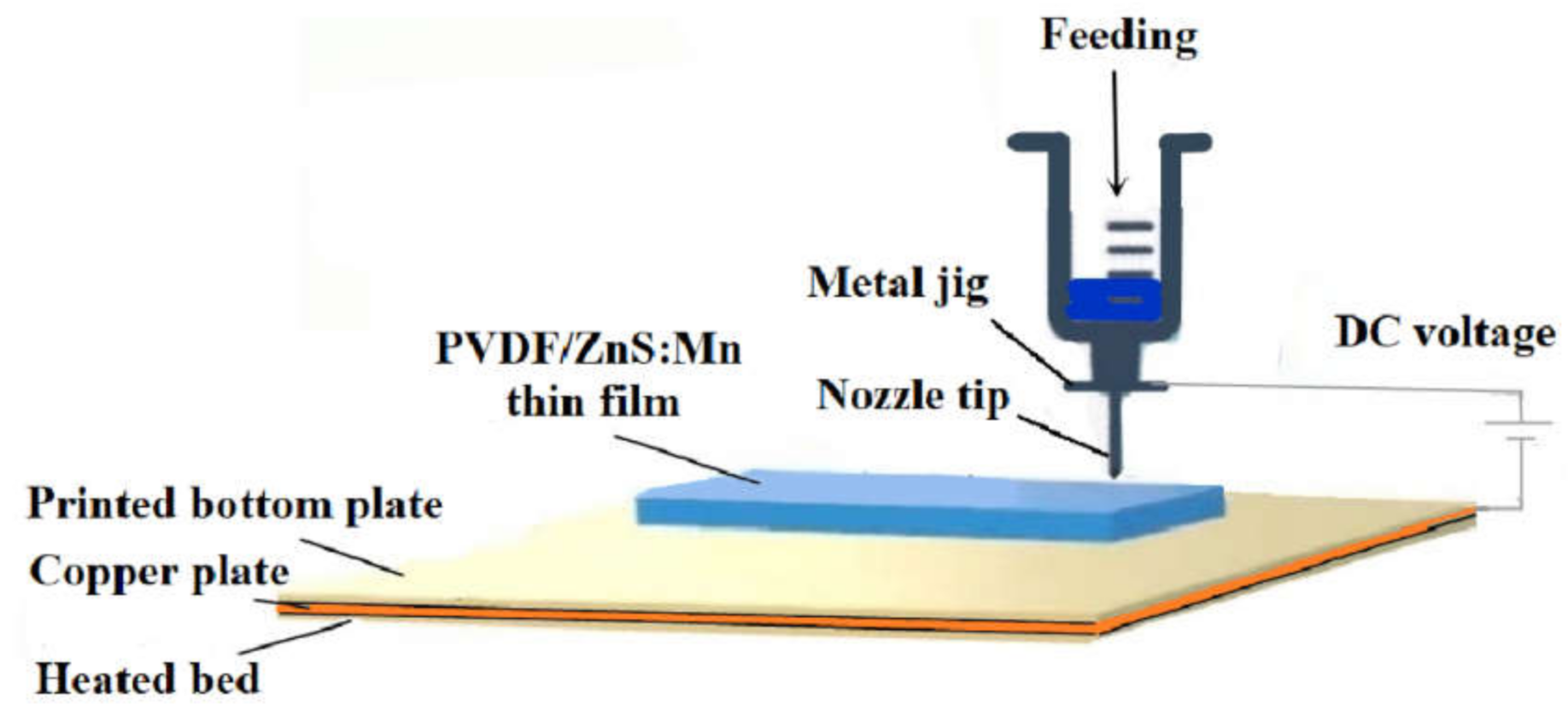
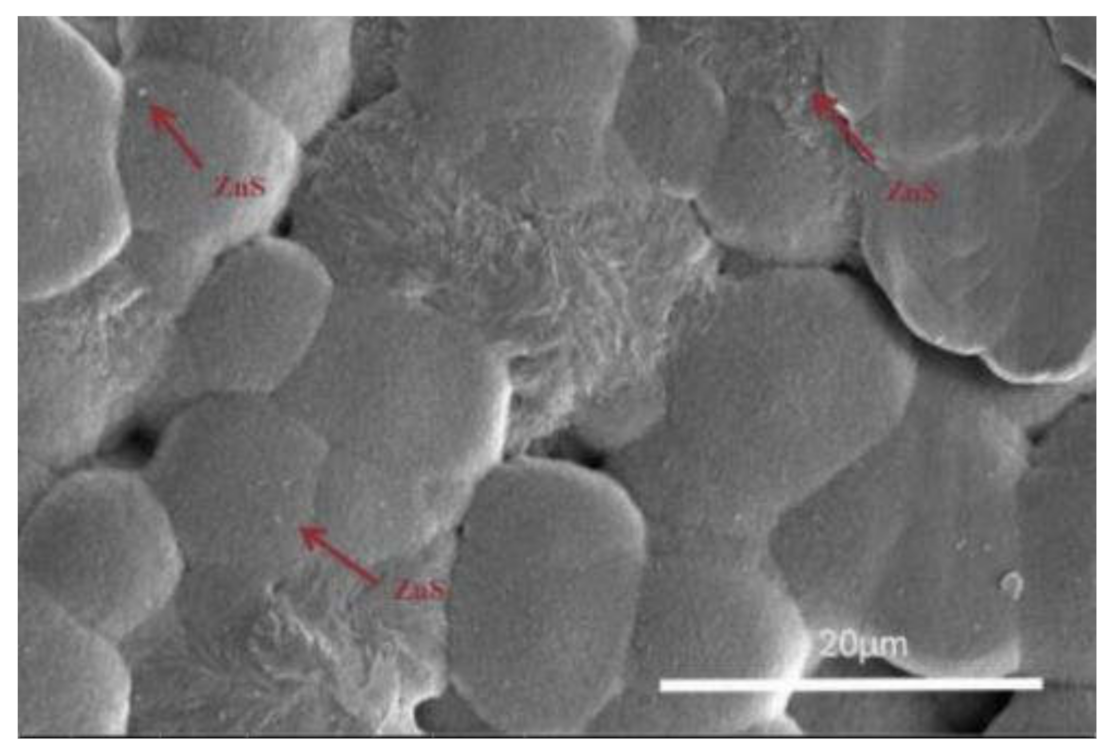
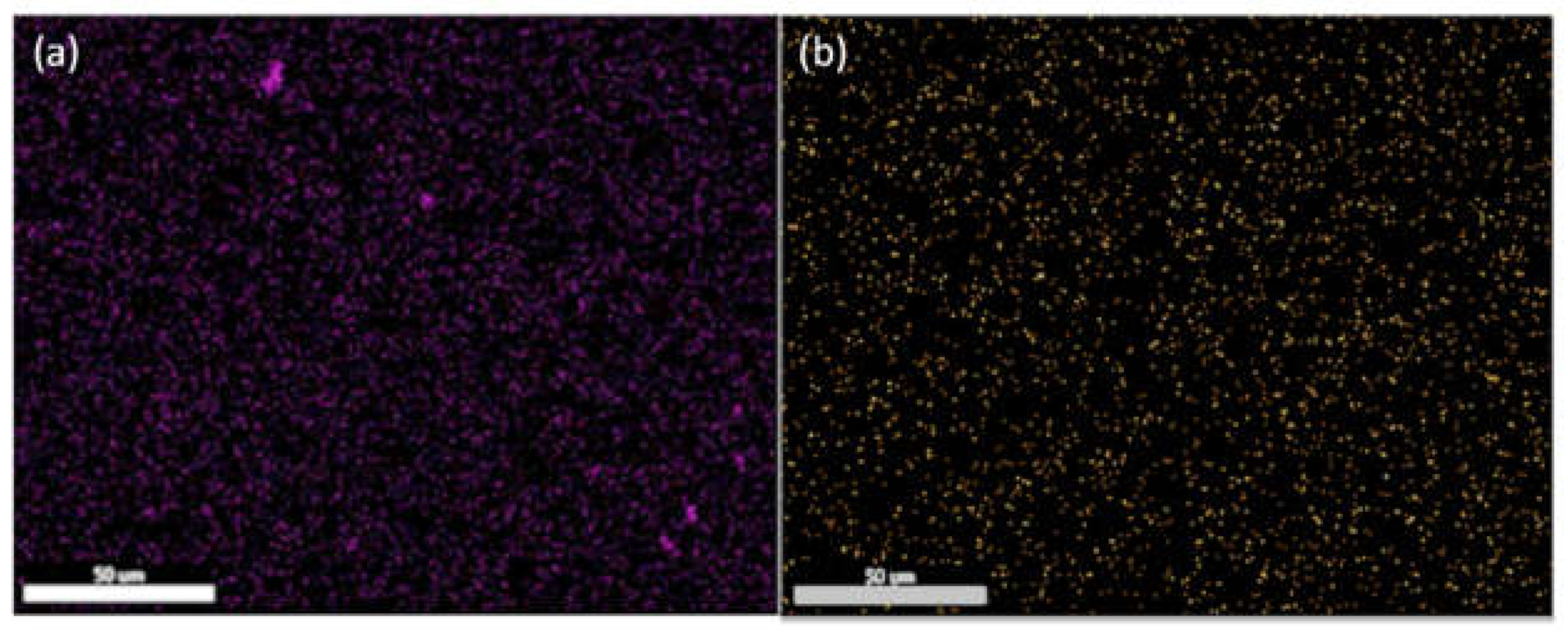
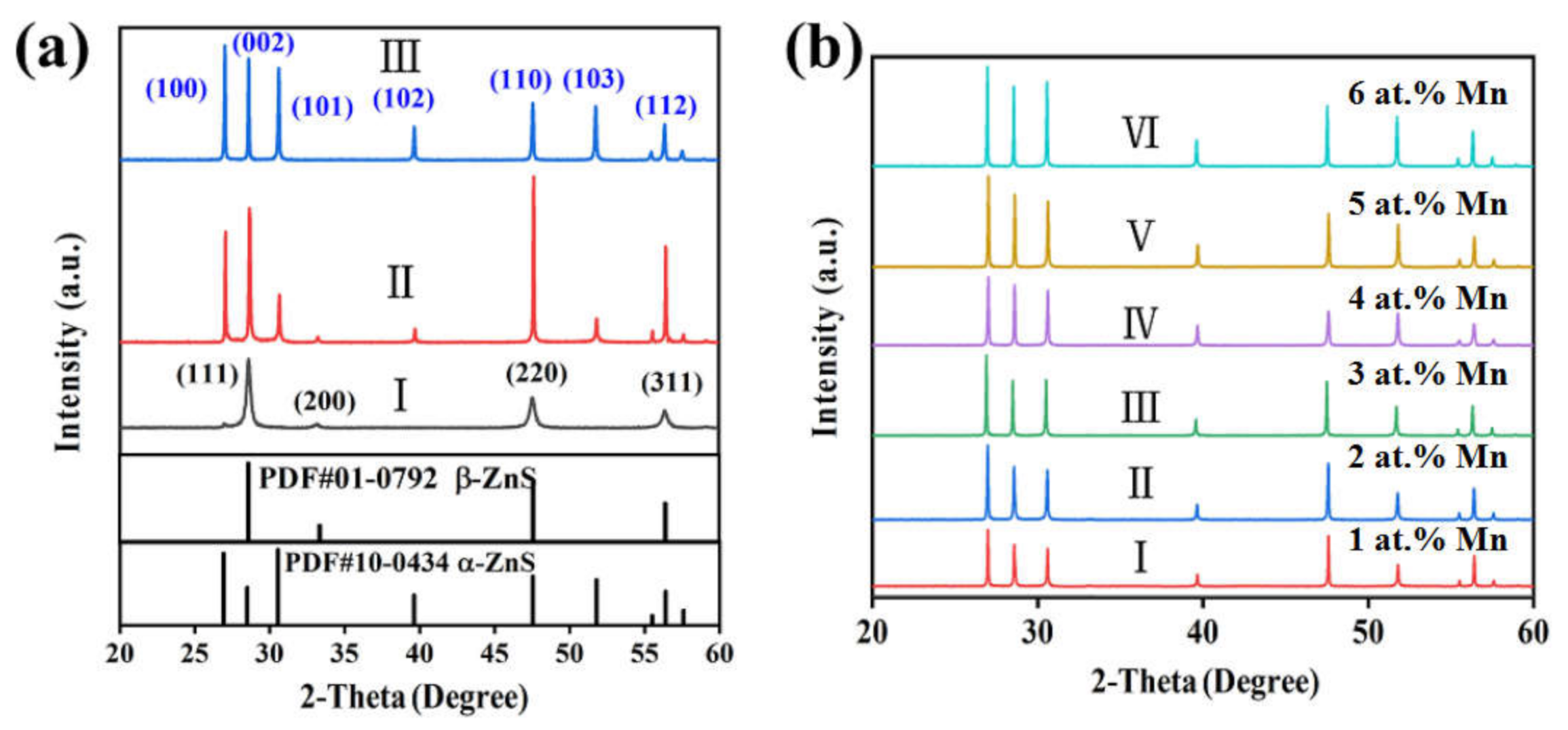
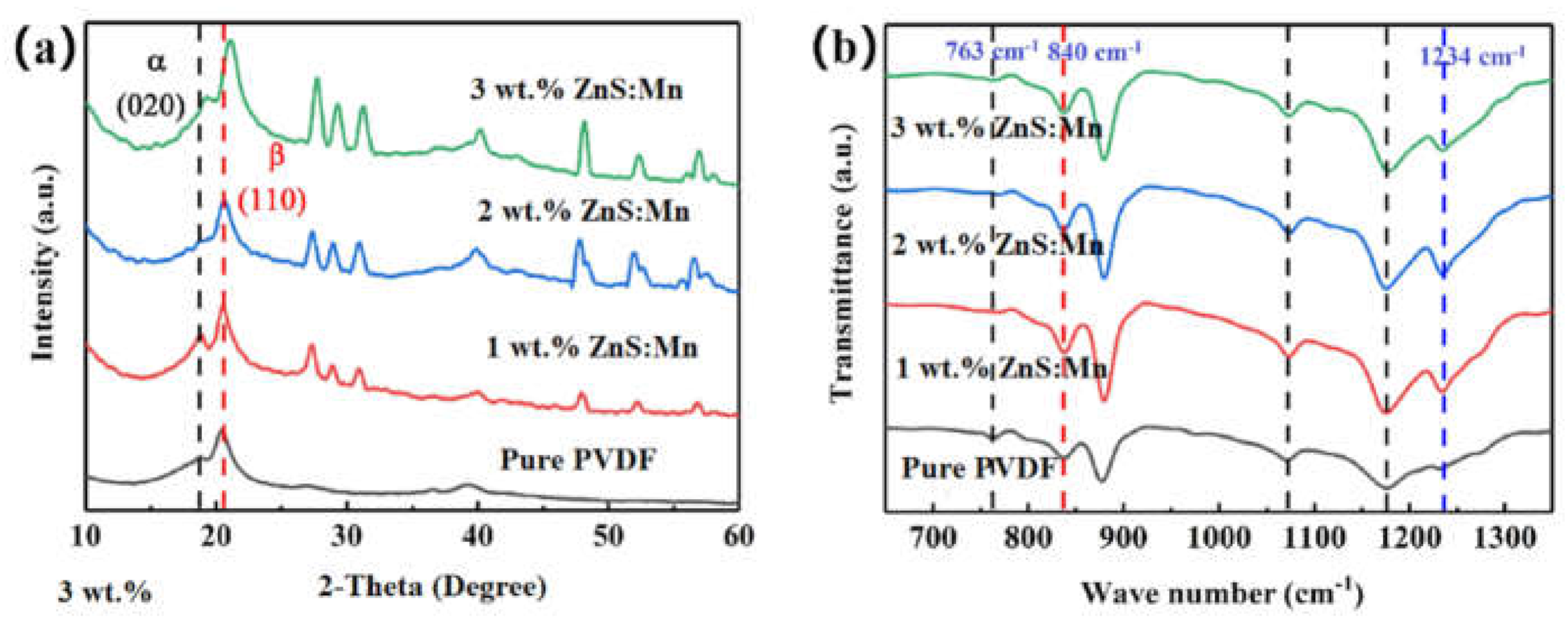
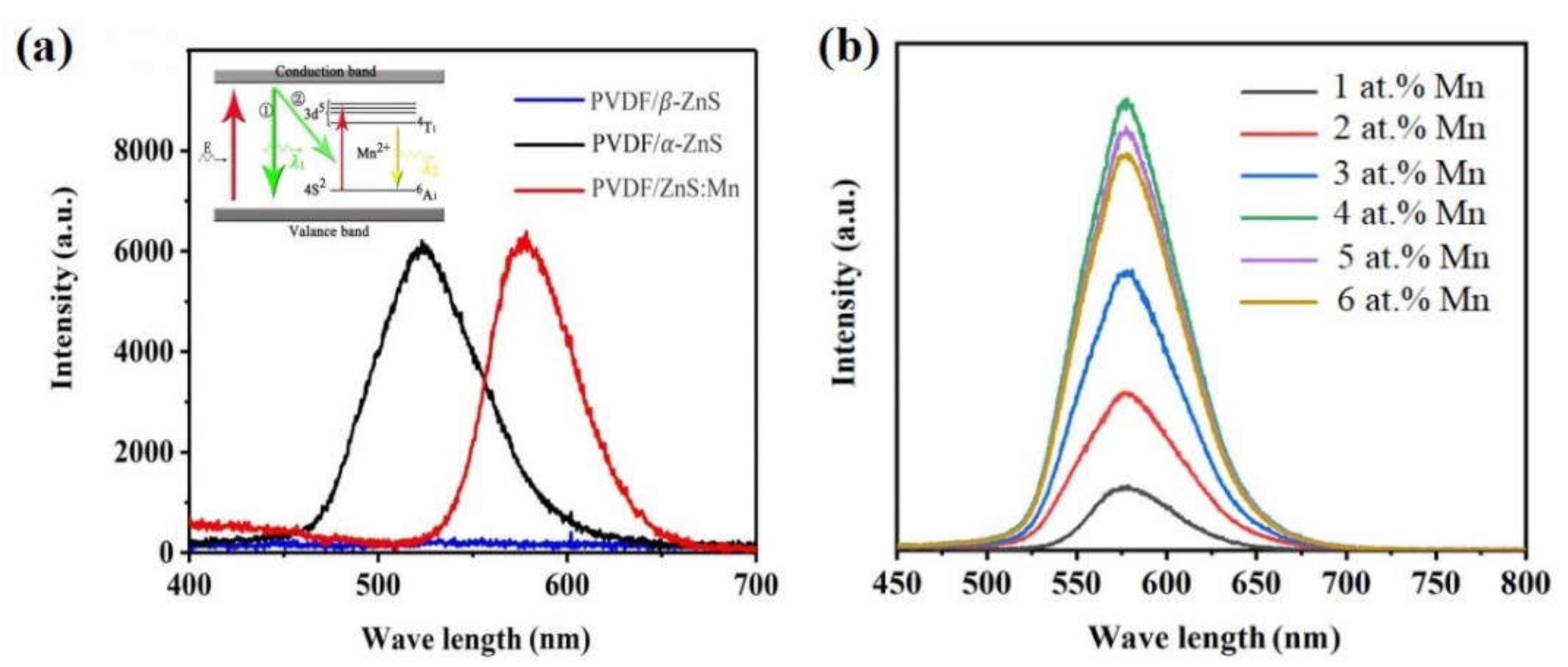


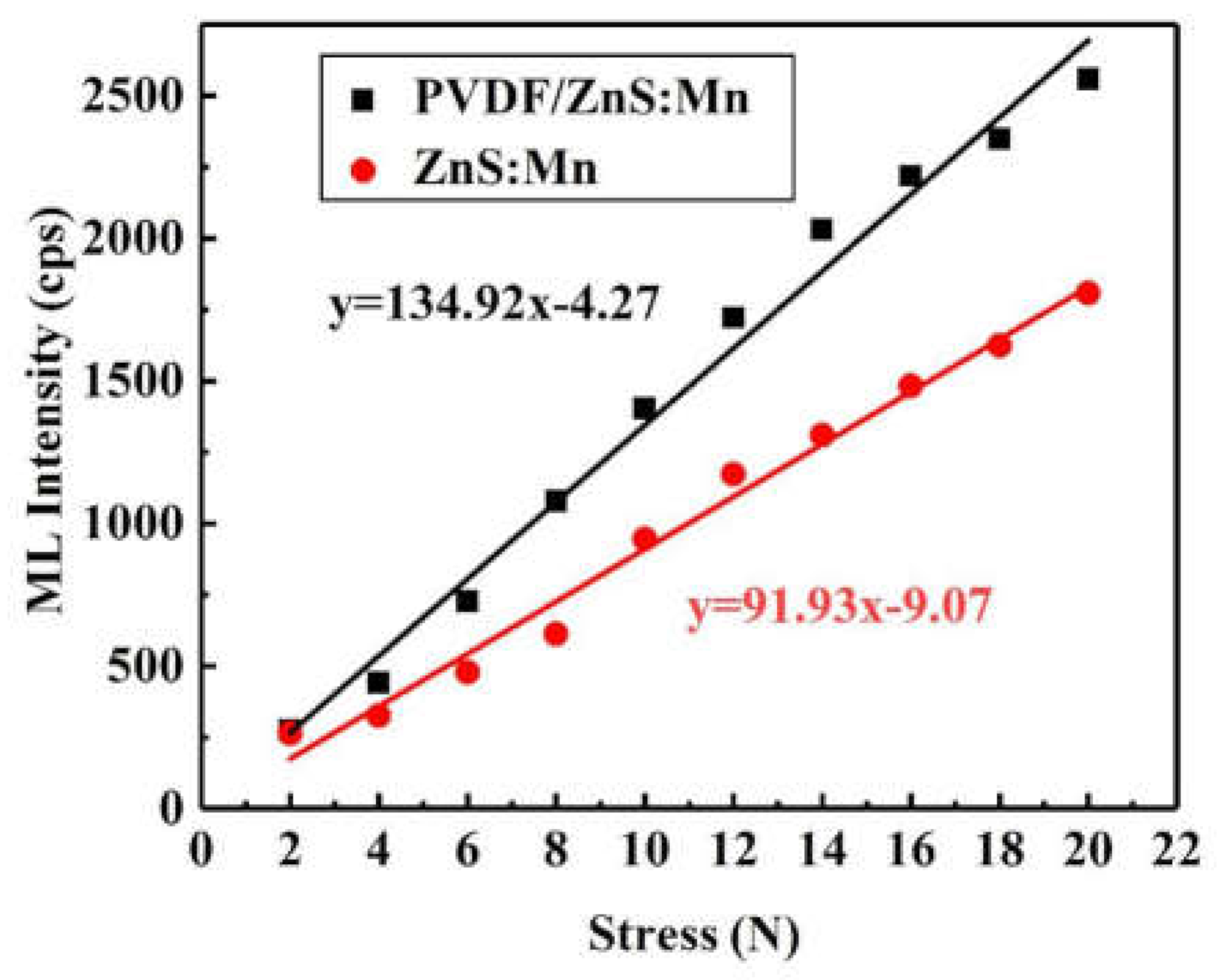
Publisher’s Note: MDPI stays neutral with regard to jurisdictional claims in published maps and institutional affiliations. |
© 2022 by the authors. Licensee MDPI, Basel, Switzerland. This article is an open access article distributed under the terms and conditions of the Creative Commons Attribution (CC BY) license (https://creativecommons.org/licenses/by/4.0/).
Share and Cite
Chen, C.; Zhu, J.; Zhang, Y.; Wang, A. Preparation and Luminescence Properties of PVDF/ZnS:Mn Flexible Thin-Film Sensors. Coatings 2022, 12, 449. https://doi.org/10.3390/coatings12040449
Chen C, Zhu J, Zhang Y, Wang A. Preparation and Luminescence Properties of PVDF/ZnS:Mn Flexible Thin-Film Sensors. Coatings. 2022; 12(4):449. https://doi.org/10.3390/coatings12040449
Chicago/Turabian StyleChen, Caifeng, Jing Zhu, Youming Zhang, and Andong Wang. 2022. "Preparation and Luminescence Properties of PVDF/ZnS:Mn Flexible Thin-Film Sensors" Coatings 12, no. 4: 449. https://doi.org/10.3390/coatings12040449
APA StyleChen, C., Zhu, J., Zhang, Y., & Wang, A. (2022). Preparation and Luminescence Properties of PVDF/ZnS:Mn Flexible Thin-Film Sensors. Coatings, 12(4), 449. https://doi.org/10.3390/coatings12040449







